
Abhay K’s Art ‘Shunyata | Emptiness’ Explores The Silent Power Of Impermanence
NEW DELHI (ANI) – Artist, poet, and diplomat Abhay K brings together poetry, philosophy, and visual art in his latest collection Shunyata | Emptiness, offering a contemplative and powerful interpretation of the Buddhist concept of emptiness—or Shunyata.
Inspired by the Heart Sutra’s profound line, “Form is emptiness, and emptiness is form,” the exhibition invites viewers into a meditative journey where minimalist forms and subtle details explore the transient nature of existence. It is both an aesthetic experience and a philosophical exploration, urging viewers to reflect on what lies beneath the surface of things.
The idea, Abhay K revealed, emerged during a moment of stillness.
“It came to me while I was staring at a blank canvas,” he said. “I saw forms appear and disappear, just like thoughts—mirroring the impermanence of life itself.” That spark ignited a series of paintings that deliberately blur the boundaries between form and void, motion and stillness, presence and absence.
“Shunyata is a philosophy that refers to the emptiness of independent existence,” Abhay K explained. “It was imparted by Bodhisattva Avalokiteshvara to Shariputra at Griddhakuta Parvat in Rajgir, Bihar. I come from this very place, and I encountered this philosophy while researching for my book Nalanda: How It Changed the World. Inspired by its depth, I chose to depict it through my paintings.”
The canvases in Shunyata | Emptiness are anything but empty. They are textured, layered with brushstrokes and circular motifs that resemble celestial bodies—suns, moons, or black holes—each evoking the cyclical, ever-changing nature of the universe. From a distance, these intricate compositions melt into soft hues and shadows, subtly reinforcing the theme of transformation and impermanence.
Rooted in Eastern philosophies and echoing the introspective depth of Western thinkers like Schopenhauer, Abhay K’s work transcends cultural boundaries. It speaks not only to the intellect, but to the inner self—encouraging viewers to pause, to feel the silence between strokes, to experience the shift between seeing and unseeing.




